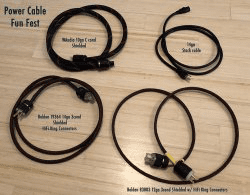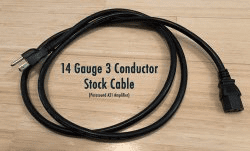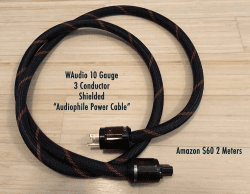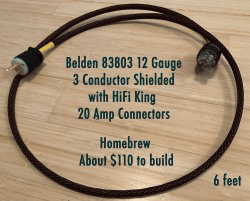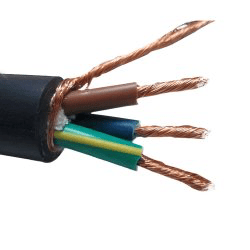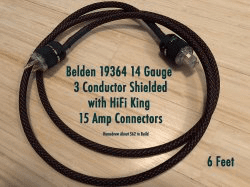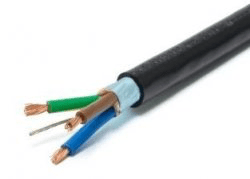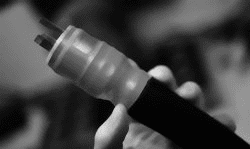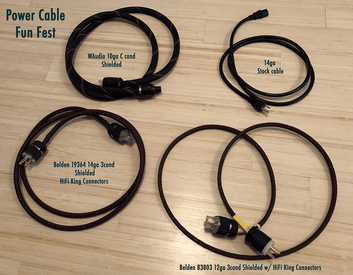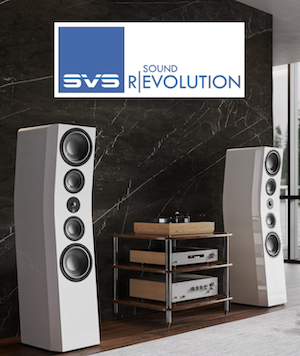You’ve got the Power (cables)!
WHY?
Ok…. I have been reading and studying the current debate about power cords making a huge difference in the sound and video of an AV system. The electronic tech part of me has long held the opinion that this is just nonsense.
The Audiophile/Videophile part of me, if there is such a part, just wanted to BELIEVE.
All of my power cables have, up to this point, been factory supplied cables and I have been happy enough with that. I have trusted that the manufacturers of high quality equipment would not supply a power cord that would let their designs and equipment fall short of expectations. I also have trusted those designers to meet the FCC emissions guidelines and their ability to design high quality power supplies and filtering into those pieces of equipment.
But we’ve all seen pictures of those firehose sized speaker cables and power cables and secretly wondered… is it true? Would it be that much better? Should I just give in and re-mortgage the house?
And still those websites, those White-Papers and those BLOGs just kept calling… kept whispering their Siren’s song in my ears. Get Better Audio, Better Video, Soundstage for MILES, Better Clarity, Lower Noise Floor, Better Bass Extension and Definition, Crystalline Euphoric Highs, Transcendent Midrange, Completely “Black” Backgrounds, Improved Dynamics… you will hear instruments you had never imagined were even there!…. The whispers sang all this and more to me…. You name it and they promised it!
I couldn’t believe it, so I had to try it!
And so, in a sense, I caved in…. a bit anyway.
I started with a some research as I always do. There are plenty of articles/BLOGs/treatises out there on both sides of the debate and surprisingly very little in the middle-ground.
Examples;
I read a thread where a person had tested over twenty different power cables and posted and described a different sonic signature for each cable. Huh?
I saw some pictures on Gizmodo where someone’s cat had eaten thru his $300 power cord only to reveal about $15 worth of components with a 14 GA power cord inside.
I checked out double-blind testing threads (the results were ambiguous). http://thegoodstuffreviews.blogspot.com/2015/05/power-cords-science-or-audiophile-hype.html (go all the way to the end :-)….
I checked out hate rants and love fests…. The scientific and not so scientific…. It was endless….
And, I started noticing something pretty quickly.
Most of the haters (detractors) were invariably engineer types spouting science and physics as meeting the burden of proof (how dare they!). Most of the lovers were either those white-paper-writing designers/manufacturers of the power cords or “fans/BELIEVERS” of The Power Cord Promises.
Coming down firmly on the “engineering” side of things, but still wanting to either prove or dis-prove the claims for myself, I devised a quick subjective test (or, not so quick as it turned out :-).
Since I don’t have the financial wherewithal (or the desire) to purchase the über expensive power cables that run $100’s or even $1000’s per foot (to quote a true philosopher of our times… “no I can’t go for that – nooo – no can do”) I tried to develop a meaningful experiment on the "cheap" that might prove or disprove the power cord hype being currently pushed.
Now “doing it on the cheap” wasn’t necessarily cheap as I found out. I decided, based on the outrageous claims and prices of the big players in the power cord market, that I would buy one cable that claimed to be an “Audiophile” power cable and build the rest.
One thing I quickly found out as I searched for an affordable cable was adding the word ”Audiophile” in front of any search did insane things to the prices. Try it and you will see what I mean :-)
I finally settled on testing four power cords of the same length (two meters - 6’6”)
1. Stock power cord from my new Parasound A21 power amp – 14 gauge - 3 conductor - No shielding – Molded construction
2. WAudio “Audiophile Quality” power cord – 10 GA – 3 Cond – Shielded – discrete components (covered in TechFlex so no idea who makes the wire)
3. Homebrew #1 “Audiophile” power cord – Belden 83803 – 12 GA – 3 cond – shielded – AweKing 20 amp male and Hi-Fi King 15 amp IEC connectors
4. Homebrew #2 “Audiophile” power cord – Belden 19364 – 14 GA – 3 cond – shielded – HiFi King 15 amp connectors
Construction
Stock Cable – Parasound 14 Ga, 3 cond – Molded plugs
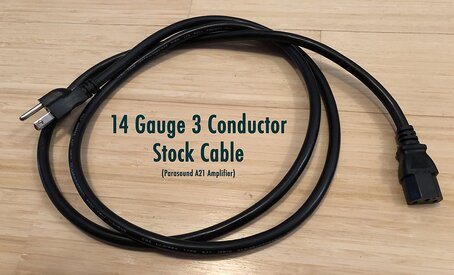
WAudio Hi-End Hifi Audio AC Power Cable Power Cord US Plug - 6.5FT (2M)
Amazon $59.99
https://www.amazon.com/gp/product/B01L2UNMXI/ref=ppx_yo_dt_b_asin_title_o06__o00_s00?ie=UTF8&psc=1
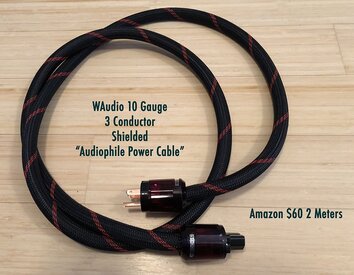
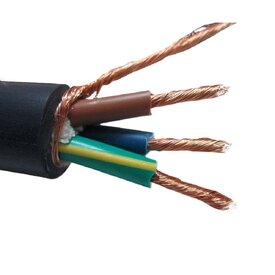
My first order of business was to check the construction of the WAudio “Audiophile Power Cable”.
First inspection of the cable revealed no overt problems or issues. Build quality looked good and cosmetically it looked very nice. It is a full ¾ inch thick and covered in TechFlex. I took apart the plugs on both ends to determine build quality and found the connectors to appear sound and well built. The wiring was clean with no stray strands floating about. The shield was properly connected with the ground wire to the ground pin on the male plug side (supply/wall) only. The wire brand was unidentifiable because of the TechFlex covering but was certainly 10 Gauge and shielded. No idea of the quality of the shielding could be determined by inspection other than it is a braided shield construction (so 60-85% is likely the shield coverage). There was no evidence of a foil shield that I could see. The connectors appeared robust and well-made and were branded WAudio. All-in-all a pretty cable for $60…
“Homebrew" #1 Cable – Cost to make approx. - $118.00
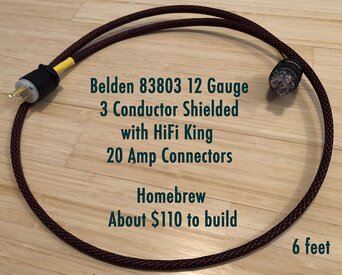

1. Belden 83803 12 GA – 3 Cond Shielded – Parts Express - $12.90 per foot
2. Hi-Fi King CC-18 IEC Plug 15A/125VAC – Amazon - $12.00 ea
3. Aweking 5-20P Male Connector 20 Amp 125VAC – Amazon - $20.00 (Hubbell would also be an excellent choice)
4. TechFlex - ½” expandable covering – 25 feet - Amazon - $8.00 (or 32 cents per foot)
The Belden 83803 is considered a high end instrument power cable. The conductors are 12 gauge (7x20) stranded. It is 100% Beldfoil shielded with an overlaid 85% tinned copper braid shield and a separate drain wire. Teflon insulation inside and out. Low capacitance and very low resistance (1.7 ohms per 1000 feet!) make this a near ideal power wire.
Because of the heavy gauge it is somewhat inflexible and stiff but not overly so.
"Homebrew" #2 Cable - Cost to make approx. - $48.00
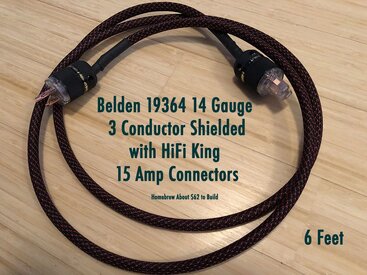
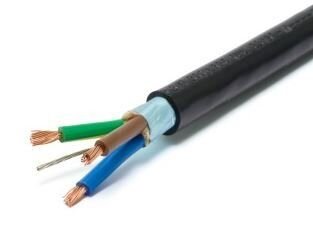
1. Belden 19364 14 GA – 3 Cond Shielded – Wire and Cable Your Way - $3.33 per foot (20 foot Minimum Purchase)
2. Hi-Fi King CC-18 IEC Plug Female 15A/125VAC – Amazon - $12.00ea
3. Hi-Fi King PU-18 Plug IEC Male 15A/125VAC – Amazon - $12.00ea
4. TechFlex - ½” expandable covering – 25 feet - Amazon - $8.00 (or 32 cents per foot)
Belden 19364 is also considered a very high end cable in the instrumentation field for AC power applications. It is a 14 gauge 3 cond stranded (7x28) cable. It is 100% shielded with a foil shield and sperate drain wire. The thick PVC jacket make it thicker than the heavier gauge Belden 83803 cable. But even though thicker it is somewhat more flexible than the 83803.
Note: The Belden 19364 has long been appreciated as an “Audiophile Power Cable” in Europe.
*****************
With my “Homebrew” cables I was confident in my DYI skills and the build quality. In building the cables I did use a layer of shrink tubing over the TechFlex at each connector to provide a better strain relief and to cover the ends of the TechFlex which can fray after cutting. I made sure to ground the shield(s) at the supply side only to provide the proper noise “drain”.
The Testing - The Plan – The Equipment
The other equipment that would be used for this rather informal testing would be;
Marantz 7703 Pre/Processor
Parasound A21 Power Amp
OPPO UDP-203 - HDMI out
Furman Elite-20 PFI Power Conditioner
Dedicated 20 amp line
BG Radia 520i front speakers
Music - Harlequin - Dave Grusin and Lee Ritenour – Track 1 - Harlequin
My initial testing would be done by starting with my baseline reference the Parasound stock 14 GA power cord. I would then swap out the stock cord for each of the “Audiophile” power cords listed in turn. I would go back and forth between each cord and the stock cord at least three times. After three swaps I would move to the next power cord and repeat the process.
I set my system up to play the Harlequin in stereo while listening in the Marantz “Pure Direct” mode. Subwoofers and Audyssey programming were bypassed for testing. I would do the swap and listening test at least three times for each cable.
Just to keep things brief, since the results were the same across the board, here are the results of the first swap out by cable…
First Test Results
1. Stock 14 GA cable
This was to be my baseline reference
– Baseline
2. WAudio “Audiophile Quality” power cord – 10 GA – 3 Cond – Shielded – discrete components (covered in TechFlex so no idea who makes the wire)
– No Change – No Improvement
3. Homebrew #1 “Audiophile” power cord – Belden 83803 – 12 GA – 3 cond – shielded – HiFi King 20 amp connectors
– No Change – No Improvement
4. Homebrew #2 “Audiophile” power cord – Belden 19364 – 14 GA – 3 cond – shielded – HiFi King 15 amp connectors
– No Change – No Improvement
Well…that was disappointing to say the least. I fully expected (read hoped) the veils would pull back, the angels would sing and the sound would be magnitudes better that that stock power cord.
But, alas, there was no sense of audio nirvana to be had…. “Bummer!” I thought.
Second Test
So I devised a second test. Maybe it was the other components power supply keeping me from realizing audio perfection. I made another Belden 19364 power cord for my Marantz Pre/Proc and my OPPO UDP-203 and redid the test with all four cables and then again swapping the Marantz and OPPO cables in and out with their stock cables.
Bah! No Joy!! Same results…. Stock Vs. Custom… same results…No Change – No Improvement!
Third Test
Hmmmm… I had a sudden notion. I would repeat the testing but plug directly into the dedicated 20 amp outlet bypassing the Furman Elite-20 PFI power conditioner. I mean... what if the Furman was holding the cables back?
On the first listen with the stock power cable I was somewhat taken aback! I heard a difference! Thinking I must be hallucinating I swapped back and forth between the Furman and the direct outlet several times. Yes! There was something there!
I cycled through each of the power cables in turn and heard the same improvement with each when bypassing the Furman. Unfortunately for the “Audiophile Power Cable” mythos the improvement/change that I heard was the same despite which of the four cables was used.
Here is what I heard….
1. Bass was slightly, but noticeably, more defined and solid
2. Highs and mids were the same but the upper registers were more transparent and slightly more “articulate”sounding.
3. The overall sound was definitely more defined/refined. I could hear some of the subtle percussion instruments come forward in the mix.
4. The soundstage remained the same but there was a general feeling of more “air” in the overall sound.
It wasn’t a huge, in-your-face change as much as a subtle, but noticeable, change.
Since I wanted to protect my amps from surges I purchased and installed Leviton 20 amp in-wall surge protectors replacing the standard duplex outlets in both my dedicated 20 amp circuits. I reran the tests just to be sure and the new surge suppressors caused no change in the sound or perceived improvements I had heard.
I now have my big Parasound A21 and A52+ amplifiers plugged directly into each of my dedicated 20 amp outlets with the Furman’s Elite-20 PFI power conditioners plugged into the outlet directly below the amps on those same two circuits.
Since I now had enough “Audiophile” power cables to connect my major pieces that is what I did. The main power amps are connected with the Belden 83803 cables and my Marantz AV7703 is connected with the Belden 19364 cable. I used the WAudio 10 ga on my OPPO UDP-203 and another Belden 19364 on my little Parasound ZoneMaster 450 amplifier. I made and used another Belden 19364 cable from Furman Power Conditioner to Furman wallplate that connects via 14ga Romex supplying power to my projector. My Yung plate amps were lastly connected with the Homebrew #2 14 ga cables.
But Wait! That’s not all!
After connecting everything with my new “Audiophile Power Cords” I did notice one more small but important improvement. I have had some low level “Hash” noise in my system that I have slowly eliminated bit-by-bit but was still audible. It was so low I had to literally place my ear on the speaker to hear it.
On a whim I checked it again and the noise is completely gone!
“Reaffirmation”
Just to reaffirm that I was not crazy I recreated my experiment in a different system on a smaller scale. I visited a fellow AV enthusiast and tried a quick experiment in his system by bypassing his power conditioner (Belkin PF 60 15Amp) and going direct to the wall outlet using his stock power cord (also from a Parasound A21 amplifier) and the WAudio Power Cord that I brought along. He immediately noticed the same improvements/changes (in more or less the same degree and in the same parameters) without my prompting when bypassing the power conditioner. He uses a Marantz AV8805 Pre/Processor, Parasound A21 amp, OPPO UDP-203, and Martin-Logan Montis speakers for front right and left.
My Conclusions
1. “Audiophile Power Cables” are not a valid upgrade if you are expecting huge improvements to the SOUND of your system.
2. The Extravagant amounts of money that can be spent on high end power cords is better spent on room acoustics or equipment upgrades!
3. If you live in a noisy, dense RF environment, as I do, there MAY BE some improvement in the noise floor by using correctly made shielded power cables (or, then again, there may not be any improvement if the noise is not coming in through the power cable or the power cable is not in a highly active RF environment).
4. Plugging power amps directly into the wall may actually give you more of an real improvement in sound. And then again, depending upon the way you have implemented your brand and type of power conditioning it may not render an improvement as mine did!
5. Bottom Line - Big garden or fire hose sized power cables may look cool but real improvements in sound or picture are unlikely.
With some of these cords costing north of $17000.00 for 1.5 meters thats a lot of meaningful upgrade money.
Well that’s all for now. I’m going to keep playing and experimenting and would welcome and love to get your comments and suggestions on this paper. I would also love to hear any similar experiences or impressions you may have on power cords and/or cables in general.
Cheers!
Tom
Epilog
A note on my cable philosophy.... I have been in the business of audio and electronics for a long time. At one time (ah... the 70's) I even owned part of a 24 track recording studio we wired ourselves (everything but the 110/220VAC that is… we had licensed electricians do that). We also ran sound for local bands and sold large scale PA's (one of my partners continued in this business and has only recently retired). So, that said, I have some experience with cabling, grounding and power distribution to large and complex audio systems. IMHO, keeping in mind that it is JUST MY OPINION... High end cables are just not worth the very small differences, if any, they provide.
The job of a cable is to deliver, without undue change to the signal, to the next device. If a cable radically alters the sound it is not doing its job. Cables should never be considered a tone shaping component of the system!
I am, however, a firm believer in the idea that quality cables DO matter, at least in the respect that they should be built WELL (mechanically sound) and of quality materials and components. And if they are built in that way the cable will perform as well as anything out there.
Having said that I do admit that I have neither the time, patience, OR THE MONEY to honestly acquire, test and evaluate the high end cable market. If anyone wants to send me some $10,000 (or even $1000) stereo pairs to compare I will certainly do my best to do an honest evaluation and return them to you. And, if you have any of those $2500 per foot power cables lying about I would love to give those a try as well :-)
Attachments
Last edited:







